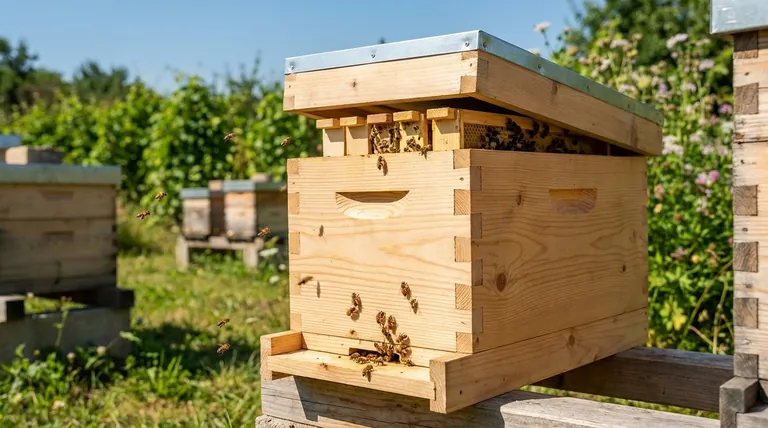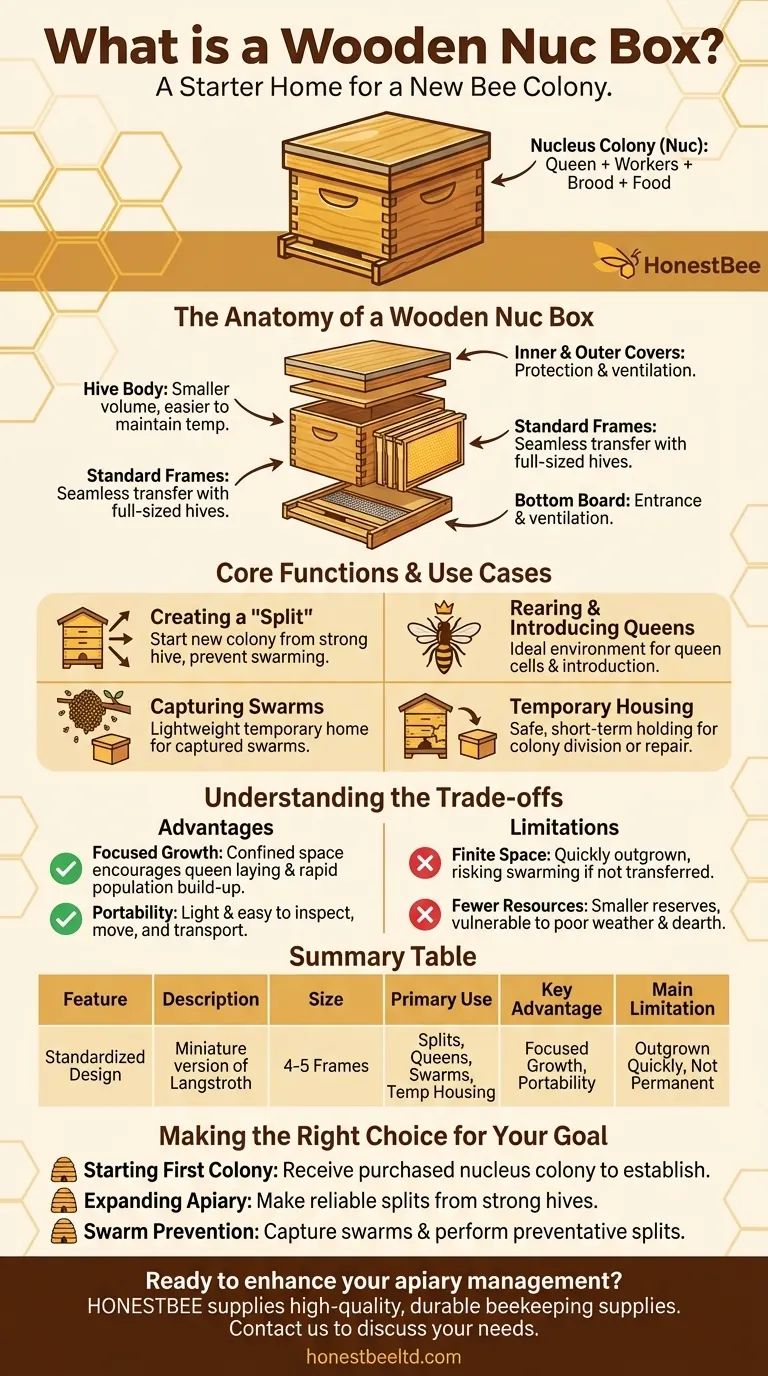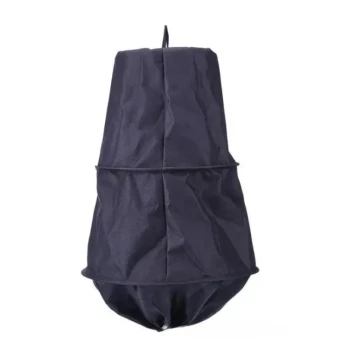In beekeeping, a wooden nuc box is best understood as a starter home for a new bee colony. A "nuc" is short for a nucleus colony, which is a small, functioning bee colony containing a queen, worker bees, and several frames of brood and food. The wooden nuc box is simply the small-scale hive designed to house this nucleus, making it a critical tool for creating new colonies, raising queens, and managing swarms.
A wooden nuc box isn't just a smaller piece of equipment; it's a strategic tool for colony management. Its primary purpose is to provide a controlled, compact environment for a small colony to grow strong before it's ready to be moved into a full-sized hive.

The Anatomy of a Wooden Nuc Box
A wooden nuc box is essentially a miniature version of a standard Langstroth hive, typically holding four or five frames instead of the usual eight or ten. This compatibility is its most important feature.
The Hive Body
This is the main box structure. Its smaller volume requires less energy for the bees to maintain temperature, allowing them to focus resources on building comb and raising brood.
Standard Frames
Nuc boxes use the exact same frames as full-sized hives. This is crucial because it allows for the seamless transfer of bees, brood, honey, and pollen between a nuc and a standard hive body without any disruption.
Bottom Board
Just like a full hive, the nuc box has a bottom board that provides the hive entrance and floor. These can be solid or screened for ventilation, depending on the design and climate.
Inner and Outer Covers
The nuc is topped with an inner cover for ventilation and an outer, or telescoping, cover for protection from the elements. This setup mirrors a standard hive, preparing the bees for their eventual home.
Core Functions and Use Cases
Beekeepers use nuc boxes for several specific, strategic purposes that are difficult to achieve in a full-sized hive.
Creating a "Split"
This is the most common use. A beekeeper can take a few frames of brood, bees, and resources from a strong, populous hive and place them into a nuc box with a new queen. This creates a new, viable colony and also helps prevent the original hive from swarming.
Rearing and Introducing Queens
The small, controlled population of a nuc box is the perfect environment for raising a new queen from a queen cell. It's also ideal for introducing a new, mated queen, as she is more likely to be accepted by the smaller number of bees.
Capturing Swarms
A nuc box is a lightweight, portable tool perfect for capturing a swarm of bees. It provides an ideal temporary home until the beekeeper can move the swarm to a permanent location.
Temporary Housing
If a hive is damaged or needs to be temporarily divided for treatment or inspection, a nuc box serves as a safe, short-term holding area for the queen and a portion of the colony.
Understanding the Trade-offs
While indispensable, a nuc box has a very specific purpose and is not a permanent solution. Its greatest strength is also its primary limitation.
Advantage: Focused Growth
The confined space encourages the queen to lay eggs in a concentrated pattern and allows the colony to build up its population quickly. The bees can manage the internal climate much more efficiently.
Advantage: Portability and Ease of Management
Nuc boxes are light and easy to inspect. This makes them less intimidating for new beekeepers and simple to move around the apiary or transport to a new location.
Limitation: Finite Space
A healthy colony will quickly outgrow a nuc box. If not transferred to a full-sized hive in time, the bees will run out of space to store food and for the queen to lay eggs, which will almost certainly trigger them to swarm.
Limitation: Fewer Resources
Because it holds fewer frames, a nuc has smaller reserves of honey and pollen. This makes the colony more vulnerable during periods of poor weather or nectar dearth, requiring closer monitoring by the beekeeper.
Making the Right Choice for Your Goal
Deciding when and how to use a wooden nuc box depends entirely on your specific beekeeping objective.
- If your primary focus is starting your first colony: A nuc box is the perfect vessel for receiving a purchased nucleus colony, allowing them to establish themselves before you transfer them to a full hive.
- If your primary focus is expanding your apiary: Use nuc boxes to make "splits" from your strongest hives, effectively growing your number of colonies in a controlled and reliable way.
- If your primary focus is swarm prevention and management: Keep an empty nuc box on hand to easily capture swarms or perform a preventative split on a hive that is becoming overcrowded.
Ultimately, mastering the use of the wooden nuc box is a fundamental step from simply keeping bees to actively managing and growing a thriving apiary.
Summary Table:
| Feature | Description |
|---|---|
| Size | Holds 4-5 standard Langstroth frames. |
| Primary Use | Creating splits, raising queens, swarm capture, and temporary housing. |
| Key Advantage | Promotes focused colony growth and is highly portable. |
| Main Limitation | Colonies quickly outgrow it; not a permanent hive solution. |
Ready to enhance your apiary management?
A wooden nuc box is a strategic tool for commercial beekeepers and distributors focused on growth and swarm control. HONESTBEE supplies high-quality, durable beekeeping supplies and equipment designed for the demands of wholesale operations.
Let us help you build a stronger, more productive apiary. Contact HONESTBEE today to discuss your equipment needs and our wholesale-focused solutions.
Visual Guide

Related Products
- 5 Frame Wooden Nuc Box for Beekeeping
- Twin Queen Styrofoam Honey Bee Nucs Mating and Breeding Box
- Automatic Heat Preservation 6 Frame Pro Nuc Box for Honey Bee Queen Mating
- Portable Bee Mating Hive Boxes Mini Mating Nucs 8 Frames for Queen Rearing
- Wholesales Dadant Size Wooden Bee Hives for Beekeeping
People Also Ask
- What is a common feature of many 5-frame nuc boxes? The Integrated Feeder for Efficient Colony Growth
- What are the benefits of starting a new bee colony in a nuc box? Boost Colony Success with Efficient Beekeeping
- What are the benefits of moving nuclei around the apiary? Master Strategic Hive Management
- What is the most common type of standard nuc? The 5-Frame Nuc Explained
- How should the nuc be installed in the apiary? Ensure Colony Success from Day One



















